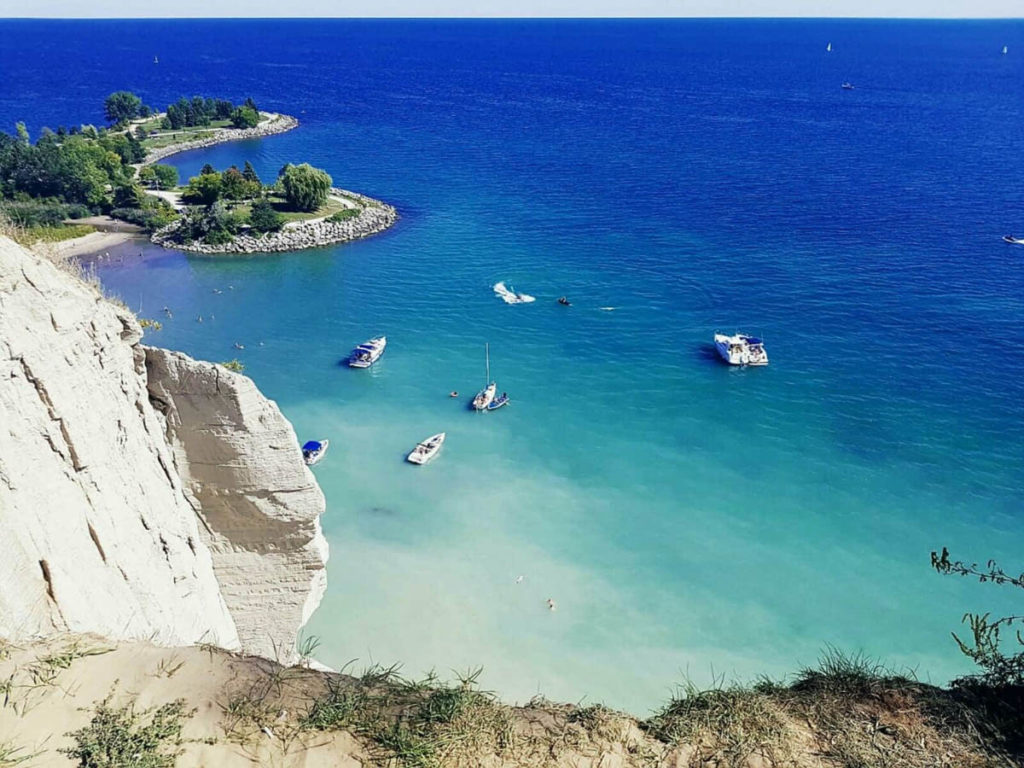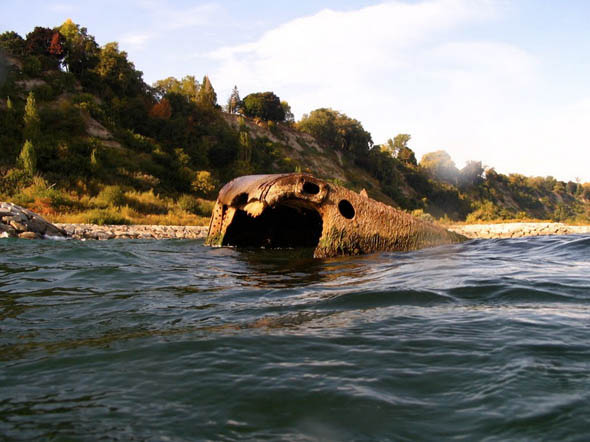In the early seventies, a group of teenagers were hanging out at Sylvan Park and looking down from the edge of the Scarborough Bluffs. One of them points to an object some 100 meters down in the water at the foot of the bluffs. “What’s that thing ?” ‘I don’t know’ came the reply. ‘Some kind of wrecked car? “They used to dump old cars off the bluffs around here somewhere”. Someone else stated that it was a boiler. “A boiler from what?” Maybe from an old building? “The government dumps construction debris down there for land fill” Further questions were not answered by any of the teenagers and none of the neighbours nearby knew what the object in the water was.
Fast forward thirty years to 2002, and being a newly certified scuba diver at a meeting of Scarborough Underwater Club Inc., I asked if anyone knew what the object in the water off the Scarborough Bluffs was and the immediate answer: “oh yes that’s the “Alexandria”. “You can read about it in Cris Kohl’s book. “The Great Lakes Diving Guide”. I bought a copy of “The Great Lakes Diving Guide” and found amongest the 608 pages of reports of thousands of shipwrecks, a paragraph with some information about the Alexandria. I went to the archives of the Scarborough Historical Society and the Cedarbrae branch of the Toronto Public Library in search of more information.

The Alexandria (a wooden side wheeler) was built in Montreal in 1866 and refit in 1883 and measured 174 feet long with a 31 foot beam. She was acquired in a merger that resulted in the formation of Canada Steamship Lines. Steel steamers were preferred over the older style of wooden boats and she became a spare, until the Alexandria returned to service in 1915 on the Montreal to Toronto cargo run.
Captain William Bloomfield was at the helm, and Alexandria left Port Hope on a Tuesday at 10:30 am on August 3, 1915 when she encountered a tempestuous storm just east of Toronto. Normally intended to carry 100 tons of cargo the ship was loaded with about 300 tons some of which included 2,000 bags of sugar, vinegar, cheese, canned goods & furniture. This made her ride higher in the water and difficult to control. The ship was seriously under powered, with only a single cylinder walking beam steam engine rated at 50 hp.
With waves breaking over the bow the Alexandria grounded on the sand underneath the Scarborough Bluffs, and the ship began to break up. By 8:00 pm the forward 50 feet of the bow broke off and the crew took to the life boats.

As the life boats became swamped by the high waves, Scarborough farmer Ed Middleton, a former sailor, swam out into the surf under a rapidly darkening sky, and brought a lifeline. Toronto’s Life saving crew, led by a Captain Chapman arrived on the scene quickly. Other rescuers included Reeve J.E. Cornell, C. Belvan, and E.W. Lefraugh who went down the steep bluffs to form a human chain and pulled Alexandria’s crew from the clutches of the crashing waves.
At 2 oclock that Wednesday morning, the last man to leave the ship, Capt. Bloomfield lept into the waves and caught the life line. Thanking Ed Middleton for his efforts upon finally reaching shore, Middleton replied ” I had a swim, I just took a line and swam out.” After the Captain reached shore, the entire stern broke off and collapsed.
The next morning, locals were busy removing anything of value from the wreck, not only the cargo but also timbers from the smashed hull that had been strewn along the shore
Today, the top of the Alexandria’s boiler can still be seen from shore. It sits in 13 feet of water and underwater can be seen sitting on the remains of the hull planking. Attached are two cylinders which are parts of the lower end of the steam engine. A little off to the north side sits, what appears to be a pump, with a pulley attached. This wreck has been completely stripped.
This wreck sits close to a road made from land fill, but is not accessible by motorized vehicle, and is at the bottom of a path which descends 296 ft from Kingston Rd. and Ravine Dr. The entry point is surrounded by broken bricks, small round rock and construction debris (including re-bar sticking out) and large flat rocks slope at 45 degrees to the water. A shore entry is definitely not recommended.
This story was written by Michael McAllister using files from:
- “The Scanner’ – The Maritme History of the Great Lakes” (Postcards & Steam Engine drawing).
- The Toronto Public Library- Cedarbrae
- The Canadian Archeological Divers Society (Cedarbrae Library Historical Archives)







